
Social Listening is a form of market research based on social media discussions, helping to analyze brand health, campaigns, special events, and more...
Along with the development of social networks, Social Listening is also growing in application capabilities. If in the past, Social Listening was only about collecting social media data, today data collection is only a part of Social Listening. Measuring buzz volume or sentiment is no longer the only function of Social Listening. In the context of this article, let's look at old questions through a new lens: What is social listening and what role does it play in social media marketing?
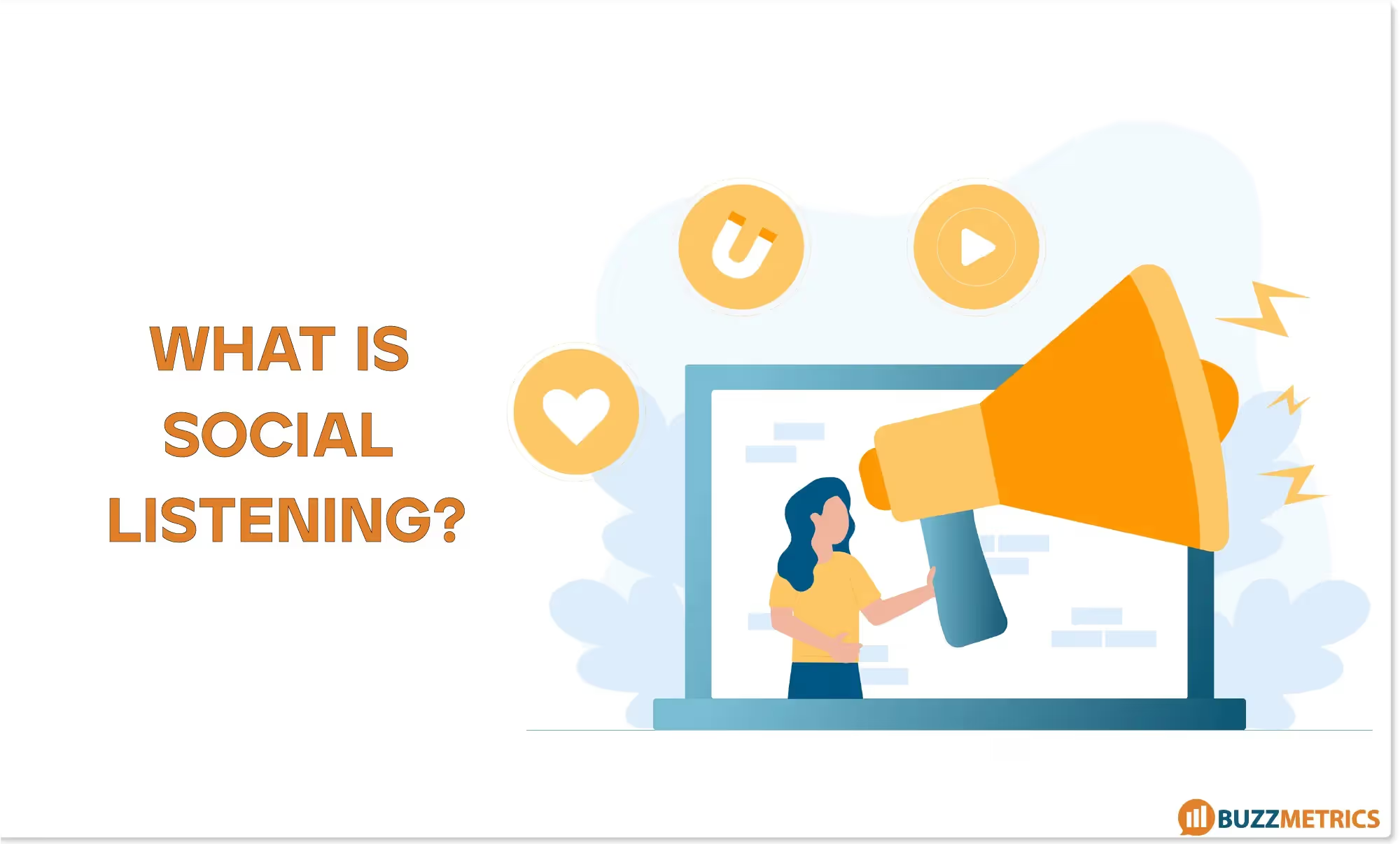
Social Listening is a form of market research that analyzes online user discussions across social media platforms. It involves the collection and analysis of conversations from various online platforms, including social media, forums, blogs, news sites, and review websites. Unlike traditional research methods, Social Listening works primarily with unstructured data, offering businesses real-time feedback from diverse users across different online platforms.
Typically, a Social Listening process follows these steps:
- Step 1: Build an analysis plan
Researchers begin by defining the context and research objectives, then set the key questions to be addressed.
- Step 2: Data collection
Using Social Listening tools, researchers gather data based on keywords from all social platforms, ensuring an accurate and comprehensive understanding of trends and industry data.
- Step 3: Data filtering and analysis
After collecting data, researchers filter out irrelevant or misleading information to ensure accuracy. Data is processed through AI systems and human verification to find potential insights.
- Step 4: Data visualization and reporting
Finally, the results are compiled into a complete report with visualized data for easier understanding and decision-making.
Social Listening data sources are not limited to major social media platforms like Facebook, Instagram, TikTok, or Threads. They also cover any medium that allows multi-way interaction, including forums, e-newspapers (comment sections), blogs, and e-commerce review sections.

(A) API Data Collection
This method connects Social Listening tools to the APIs (Application Programming Interfaces) of social networks to retrieve posts containing specific keywords.
- Advantages: Allows access to all data from the network, including personal pages.
- Disadvantages: API reliability may fluctuate, leading to incomplete or inconsistent data over time.
(B) Site Data Collection
This method involves accessing listed sites to collect data without disrupting the websites, either by manual or automatic data gathering processes.
- Advantages: Ensures 100% of data on the site is collected.
- Disadvantages: Certain issues, like site changes or blocking, may cause temporary data shortages.
When conducting research via Social Listening, marketers should focus on key metrics to gain a comprehensive view of the research landscape and measure the effectiveness of their Social Media Marketing strategies:
- Buzz Volume: The number of discussions (posts, comments, or shares) about a specific topic.
- Share of Voice (SOV): Compares the discussion volume of a brand against competitors.
- Audience Scale: The number of individuals participating in discussions about a topic.
- Sentiment Score: Indicates users' emotions toward a topic, calculated by comparing positive and negative discussions.

Initially, Social Listening was seen by many marketers as a purely measurement tool, providing basic metrics about campaigns or brands in comparison with competitors (such as discussion volume, participant count, sentiment scores, etc.). However, over time, social media has expanded significantly in scale. Users have become more familiar with Digital Transformation, sharing more than ever, and social media trends are emerging increasingly. As a result, the scope of social media data has broadened, offering a wealth of potential information to support Social Media Marketing strategies. Consequently, Social Listening has also evolved to gather data across various platforms and meet diverse research needs from marketers.
For each research focus, marketers can apply Social Listening to a range of different areas. Typically, marketers can use Social Listening for three main research directions: (1) Insight Understanding, (2) Campaign Tracking, (3) Crisis Management.
This research can provide a comprehensive overview of a specific industry, including e-commerce performance, brand image identification, and opportunities for differentiation. It also outlines the target audience's profile, capturing public attitudes and usage toward products/brands/industries.
a. Industry Competitive Landscape:
For instance, the chart below shows the most-discussed functional food brands over a certain period. From this, brands can identify their competitors, understand their position in the competitive landscape, and aim for top-of-mind awareness among consumers. Moreover, by quoting user discussions, researchers can pinpoint issues regarding public perception of both the brand and its competitors. This allows the brand to compare, recognize problems, and take corrective action if needed.

→ Read more: Exploring Insights in the Functional Food Industry: Challenges and Opportunities in the Digital Era
b. Brand Image and Differentiation:
An example of Buzzmetrics research on leading diaper brands paints a detailed picture of brand differentiation. Compared to other brands, Molfix’s product performs exceptionally well in absorbency. However, aspects like softness and thinness received negative feedback. Molfix’s branding team can also monitor current customer perceptions of competitors and identify areas for improvement.
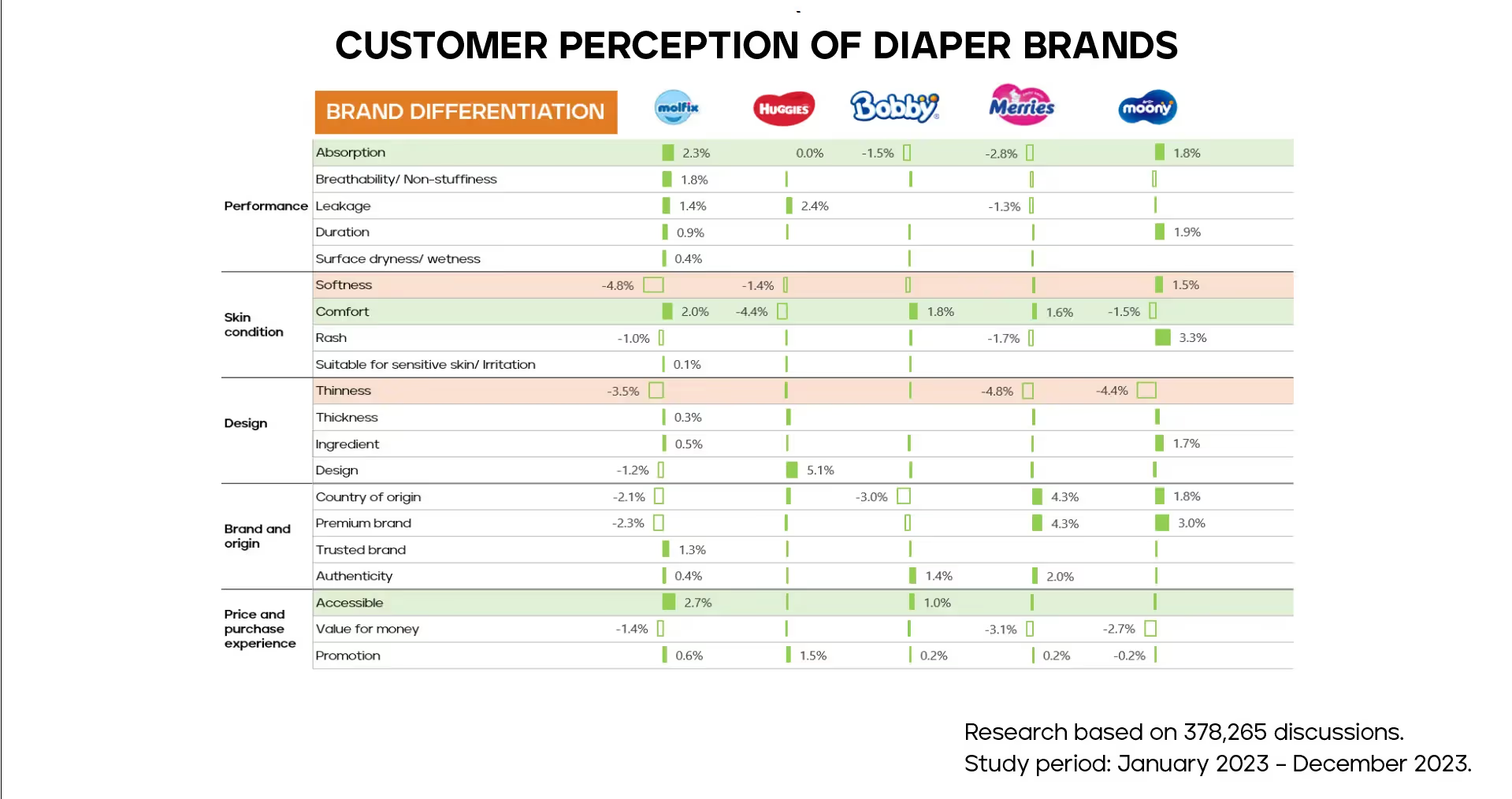
c. Usage and Attitude Research (UnA):
UnA research focuses on consumer discussions and plays a key role in unveiling the consumer landscape of an industry. It addresses key questions like:
- Users' interest levels in the product/brand on social media
- Awareness, usage, and consumer behavior displayed on social platforms
- Motivations and barriers to product/brand consumption
- General satisfaction/dissatisfaction with current products/services
- Users’ needs, unmet demands, or general expectations
d. Target Audience Segmentation:
In some cases, brands aim to understand consumers not just from a product buyer perspective but from a broader context that includes their lifestyle and habits. Social Listening can support brands in achieving this.
For instance, analyzing the most-discussed topics within Gen Alpha revealed that "love" was the top theme, surpassing even "education" and "games." This insight shows that to engage Gen Alpha, brands should consider using "love" as a central theme to attract attention and foster interaction.

→ Read more: Gen Alpha: What Sets the Next Generation of Consumers Apart?
Notably, social media is segmented by interests. Therefore, identifying user groups and their main concerns is crucial in segmenting the social media audience. Pinpointing key interests and insights will help brands align their marketing tactics with user interests. As a result, branded content and messaging are more likely to appear in users' feeds, capturing attention, generating engagement, fostering recall and affinity, or even leading to user-generated content (UGC) related to the brand.
Social Listening supports marketers in planning, creating content, and adjusting strategies in real time throughout all phases of a campaign. It helps track brand sentiment and ensures campaigns align with audience expectations.
Today, even a small complaint on Facebook can cause significant damage to a brand. As consumers become increasingly familiar with social media, the likelihood of crises occurring rises. Our Social Listening data shows that while the number of crises has decreased as brands take a more proactive role in crisis management, the average scale of a crisis has grown significantly.

Crises may seem to occur randomly and can impact any brand for seemingly arbitrary reasons. This makes social media crises difficult to track and challenging for brands to respond to. However, through Social Listening, not only can crises be monitored, but their patterns can also be identified, allowing brands to develop strategic response plans.
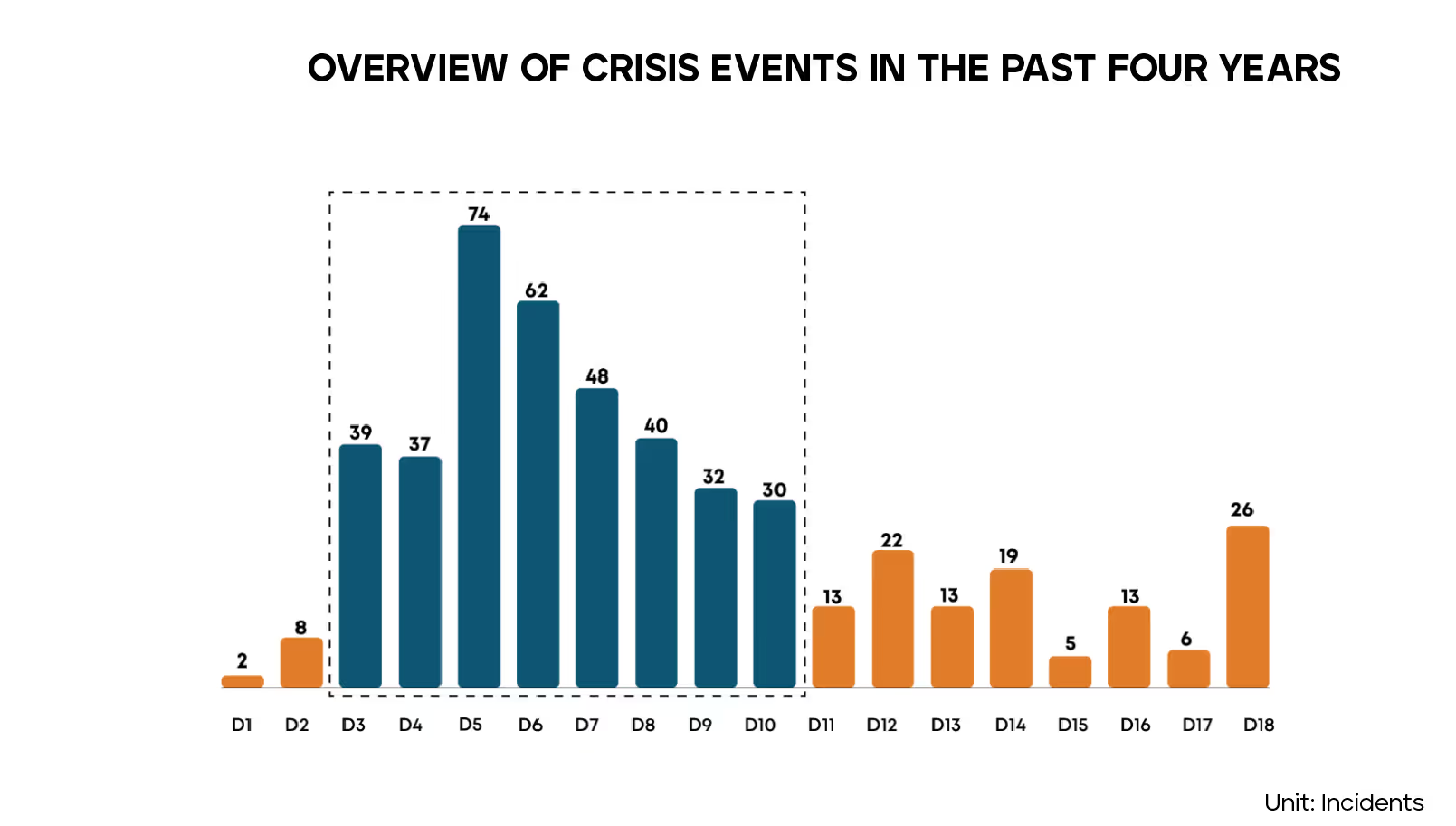
By analyzing user discussions on social media and providing actionable insights to brands, Social Listening plays a critical role in shaping communication strategies. The most common applications of Social Listening include gathering insights, tracking campaign performance, and managing crises.
To learn more about metrics, marketers can refer to here

_11zon.avif)
Following a disruptive 2021 caused by the pandemic, the banking industry has witnessed an emergence of new trends. One of the most notable in recent times is the shift toward youth-oriented content to target Gen-Z - a key customer segment with strong potential in the future.
Following a disruptive 2021 caused by the pandemic, the banking industry has witnessed an emergence of new trends. One of the most notable in recent times is the shift toward youth-oriented content to target Gen-Z - a key customer segment with strong potential in the future. Currently, when examining the share of social media discussions across age groups, Gen Y remains the most active generation while Gen-Z ranks second with 12.9%. However, Gen-Z is still in the early stages of becoming key purchasing decision-makers and their role in the banking industry is expected to grow significantly. Their distinct behaviors on social media also call for appropriate communication strategies. As a result, understanding Gen-Z and how competitors are adapting to reach them has become a strategic priority for banks. In this article, Buzzmetrics will provide marketers with the latest data and insights to navigate this emerging trend effectively.
In addition to exploring the youth-oriented content trend, Buzzmetrics also conducts research on various other topics within the banking industry. To gain a comprehensive view of this industry over the past period, please refer to the full report here.
In Buzzmetrics’ general report on Gen-Z, one notable behavior of this group is their tendency to share opinions in communities made just for them. Although they still participate in discussions across various platforms, their comments often do not reveal clear interests or expectations. This behavior is also reflected in conversations about the banking industry, posing a challenge for brands aiming to engage them. Specifically, when analyzing Gen-Z's discussion sources related to banking, official bank fanpages create less buzz than Gen-Z-focused communities and pages. Additionally, comments on banking fanpages do not show significant differences between Gen-Z and other segments: Most of Gen-Z’s comments primarily revolve around service reviews, brand quality,...
_11zon.avif)
However, analysis of Gen-Z-focused communities and pages reveals a completely different picture. On these platforms, Gen-Z begins to speak more openly about their “unique” expectations such as having lucky account number, app with features that support financial management and ATM access that is widely available,... Therefore, reaching Gen-Z requires greater effort than with other segments, as Gen-Z has higher expectations and tends to engage more actively on niche platforms.
From a branding perspective, several banks have started focusing more on communication efforts to reach Gen-Z. This shift in brand strategy is reflected in three key elements: (1) New features, (2) Creative content and (3) Communication format. In terms of features, to attract young users, many banks have enhanced their e-banking apps beyond basic functions such as payments and transfers, integrating more playful utilities. For example, MB Bank introduced a horoscope feature within its app, while TPBank integrated a virtual lucky money feature during Lunar New Year,... These additions have received positive feedback from young users, who have expressed interest in even more unique and entertaining features such as astrology maps, look up prayer guides, feng shui, daily horoscopes,...
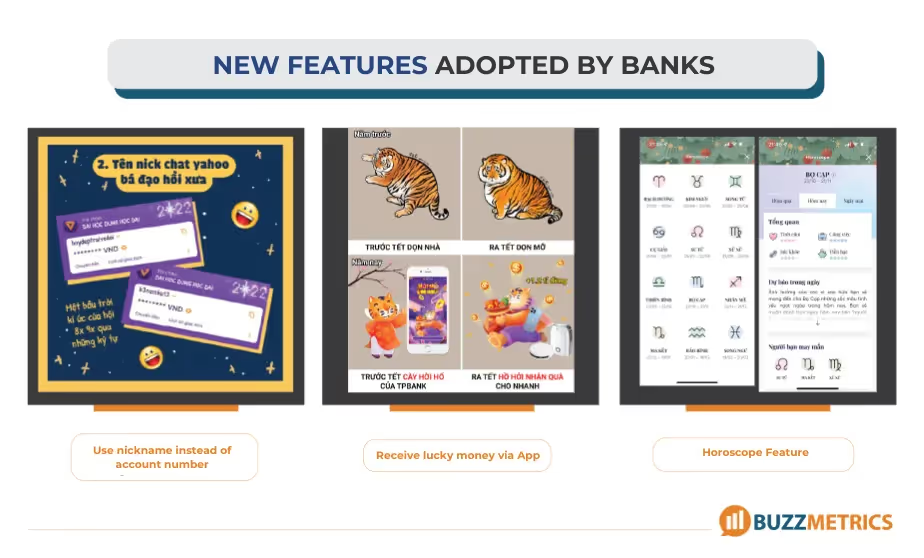
In terms of content creation, banks are showing a stronger ability to catch “trend”. Popular topics in the music scene (such as viral songs like "Mang Tiền Về Cho Mẹ" or "Si Tình") are cleverly repurposed by brands as creative material for social media posts. Additionally, many banks are now paying more attention to customizing their apps for specific occasions (during the Christmas season, E-Banking interfaces may be decorated with Christmas trees,...).
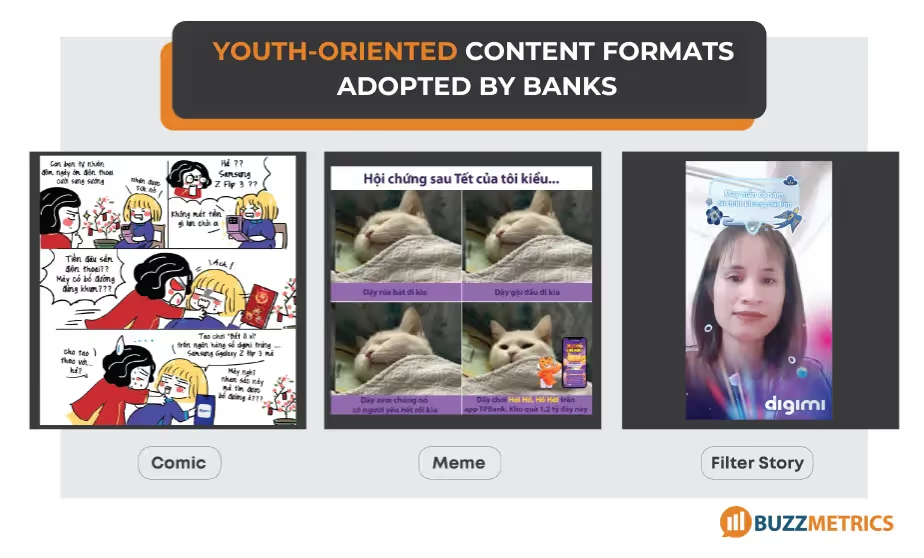
The communication format used by banks have also seen significant changes. In the past, most bank posts were lengthy and focused mainly on promoting products or outlining promotional details. Brands today are becoming more creative in embedding their campaigns into comic-style narratives, using language that feels more casual and infused with Gen-Z flavor (use social slang like “khum” or “sin lũi”,...). In addition to comic-style, brands have also introduced filter story and meme - formats that are especially favored by Gen-Z audiences.
Gen-Z is a future customer segment across various industries, including banking. As a result, brands that succeed in establishing early connections with Gen-Z are more likely to secure a long-term competitive edge. In the banking industry in particular, several brands have started creating youth-oriented content and are receiving positive feedback from Gen-Z. With an industry facing intense social media competition like banking, these brands are demonstrating a strong ability to keep up with trends and generate more positive impact compared to others.

